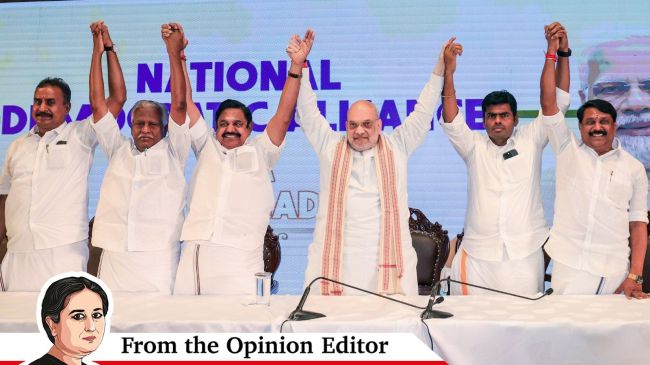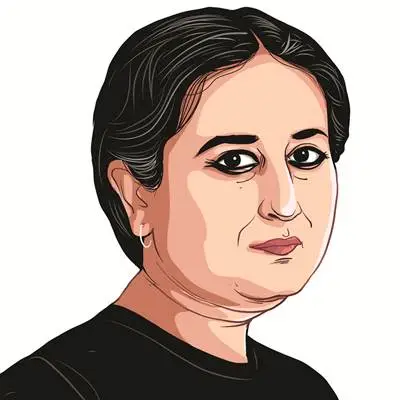Opinion Vandita Mishra writes: Coalition arithmetic and chemistry
For the polity, power-sharing pact between national and regional players, in its best version, held the promise of a democratic deepening. That pact has faded and frayed beyond recognition since — for both main national parties.
 The BJP and AIADMK were partners in the 2019 Lok Sabha election and the 2021 Assembly election but parted ways in September 2023. (Photo: X/ @AmitShah)
The BJP and AIADMK were partners in the 2019 Lok Sabha election and the 2021 Assembly election but parted ways in September 2023. (Photo: X/ @AmitShah) Dear Express Reader
This week the BJP-led NDA re-acquired an estranged ally in a state it has set its sights on. The BJP and AIADMK were partners in the 2019 Lok Sabha and 2021 Tamil Nadu elections but parted ways in September 2023. Their alliance may prove to be crucial in the 2026 assembly poll — or not. But one thing is certain: It is unlikely to significantly rebalance the larger story of alliance politics in a federal polity, starring the regional ally and the national player, which is now tilted against the smaller party.
The pact between polity-wide and single-state parties was sealed under the Centre’s arc lights after the collapse of Congress dominance in 1989, and firmed up in the 1990s through the two United Front and first NDA governments. From 1989 to 2014, the coalition era saw large ground-level shifts — because of the forces, almost simultaneously rising, of Mandal, Mandir, Market. It was a time of political fragmentation, marked by the absence of a catch-all, big-tent party. In national politics, there was much alarmist talk of instability.
But this was also a time when politics at the Centre opened up, became more federalised, with an increase in the number and diversity of parties represented. For the national party, a coalition had become a compulsion to plug the gaps in its spread and numerical strength, but it was an opportunity for the regional party. For the polity, the power-sharing pact between national and regional players, in its best version, held the promise of a democratic deepening. That pact has faded and frayed beyond recognition since.
For a brief while, the BJP’s setback in the 2024 Lok Sabha election, which led to its dependence on regional allies — after two elections in which it won decisive and crushing majorities — had seemed to signal the return of a more inclusive, if more unwieldy, politics of negotiation and bargaining. But that impression turned out to be misleading.
The third term Narendra Modi government is a coalition only in name even though allies like the TDP, JD(U) and LJP are critical to it. It has abandoned the entire repertoire evolved by earlier coalition governments of coordination mechanisms and practices, which were also fine-tuned by an earlier NDA government led by Atal Bihari Vajpayee.
Modi 3.0 has no common programme, no known coordination committees. The NDA does not have a chairperson or convenor, NDA allies do not meet with any regularity. They rely on ad hoc, personality-oriented interactions that end up disadvantaging the smaller party. When they do meet, “Allies hail PM Modi” is much more likely to be the next day’s headline, not discussions on what “coalition dharma”, a buzzword during the Vajpayee government, means today, or what it should mean.
Look closer at the BJP’s main allies today, and it is evident that they are not in a position to demand a larger space at the NDA table, or a fairer power-sharing.
Ahead of an assembly election in Bihar later this year, the JD(U) is unravelling. Its leader Nitish Kumar looks like a wan and waning political presence amid the plateauing, on his watch, of the Bihar turnaround story. A party struggling to hold on to its space in its state is unlikely to press its right to participate and to be consulted.
In Andhra Pradesh, the Chandrababu Naidu government depends on hefty financial grants from the Centre if it has to move ahead on the Amaravati and Polavaram projects, touted as game-changers for growth in a state that is depleted and bifurcated. Naidu also needs the BJP on his side to take on his strong opponent, YS Jagan Mohan Reddy. The LJP’s Chirag Paswan, at the head of a party that has lost its tall leader and then been split, is still a leader in the making.
It is no wonder, then, that all three parties, which count on the electoral support of sections of the minority, assented to the BJP-piloted Waqf Amendment Bill in Parliament that has stoked Muslim insecurities. Or that Naidu does not make delimitation an issue, and no more harps on his demand for Special Category Status for AP, the trigger for the TDP’s walk-out from the NDA in 2018. No wonder, too, that instead of driving a better bargain with the BJP, Chirag Paswan proclaims himself the “Hanuman” of PM Modi.
If the allies are weak even though the BJP depends upon them, the BJP remains strong, even though its tally at the Centre has dipped.
Despite the 2024 setback, the BJP has reset the political centre of gravity, it makes its opponents fight on its field. The personality cult around Modi is undiminished, it draws hard lines with opponents and demands submission from allies. At the same time, there is a strategic tempering.
As it sought to spread and grow in the past, the BJP was deft in using alliances, by leveraging its position as a third party in many states to form electoral pacts with the major regional parties. Now, as it tries to entrench its dominance, the challenger’s tool-kit comes in handy. In Bihar, it kept Nitish Kumar on as chief minister even though it won many more assembly seats than the JD(U) in 2020; in Maharashtra, it accommodated Eknath Shinde as Deputy CM after installing its CM following an electoral sweep; in Tamil Nadu, it has removed its state chief, an apparent concession to its old-new ally’s sensitivities.
The BJP counts, also, on regional parties’ perceptions of Congress’s continuing lack of coalitionability.
Unlike the BJP, which took to alliance politics to grow, the Congress was at its receiving end till 2004, when it formed the UPA and plunged into the game of large-scale alliances. And yet, for the ally, Congress remains unattractive. Stories abound of a less-than-engaged, still-haughty leadership. Congress does not accord the respect its ally demands of it, and does not even have the bait of power, or impending power, to paper over it.
As a result, coalition politics is now a game played between unequals with narrowing possibilities of the smaller players using it to fill gaps, nuance agendas, modify platforms. The focus is on the formation and termination of alliances. What political scientist KK Kailash has called the “middle game” has been rendered irrelevant and uninteresting.
But before it took several steps back and ground to a standstill, a politics that started as informal seat adjustments between parties had notched notable innovations institutionally.
An array of coordination mechanisms had started showing up in the 1990s — be it the UF’s Common Minimum Programme and Steering Committee, or NDA’s National Agenda of Governance and GoM (Group of Ministers), giving representation to the concerns of different alliance partners. The UPA had the National Common Minimum Programme, it continued with the GoMs, and added to the coalition repertoire a coordination committee with a partner that supported it from the outside.
That story of institutionalisation of coalition mechanisms has now been reversed more or less, more rather than less, by a government that is a coalition in form, but certainly not in spirit.
Till next week,
Vandita





